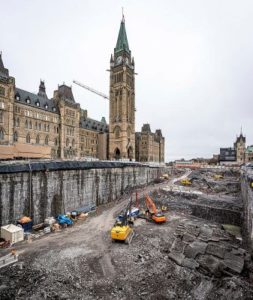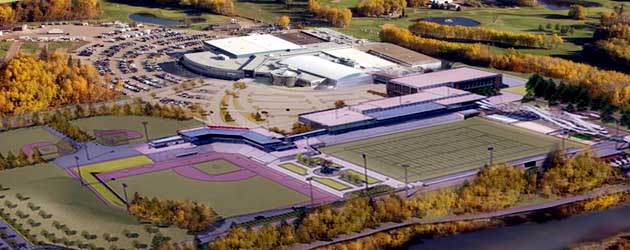When Should I be Concerned About Construction Vibration & What can I do About it?

Welcome to another edition of Frequently Asked Questions about Noise, Vibration, and Acoustics. In this series, we answer the questions we hear most often from clients or through inquiries via our website.
My name is Nick McCabe, a Senior Engineer and Associate at HGC Engineering. There are many situations where normal and routine construction activities occur, even very near adjacent structures, without any concerns related to construction vibration arising. On the other hand, there are situations where construction vibration can be a real concern. So today’s question is: When should I be concerned about construction vibration and what can I do about it?
The 3 Factors to Consider with Regards to Construction Vibration
There are a three factors to keep in mind when dealing with construction vibration considerations:
- The Nature of the planned construction activities
- The Proximity to nearby structures
- The Nature of nearby structures
These considerations seem straightforward enough, and in a sense they are. But each of the three factors have a great deal of nuance associated with them, and therefore good judgment and experience can help mitigate concerns and risk.
1st Factor: The Nature of Planned Construction Activities:
People sometimes conflate vibration that is perceptible to the touch with air-borne noise that we perceive with our ears. These are certainly related phenomena, since vibrating surfaces indoors can radiate noise and can cause motion in some lightweight surfaces. But there is certainly a difference.
For example, on some types of construction vibration sites in dense urban areas, an excavation shoring system is needed to retain the sides of an excavation. A common construction activity on these sites is the use of a large track drill to auger a hole for the vertical members of the shoring system. When these machines clear the soil off their drill, a loud bang can be heard for blocks, and as a result we have certainly received complaints about possible vibration due to this type of activity. Although those bangs can be very loud and annoying, they are not in reality typically correlated with significant ground-borne vibration.
Construction related activities which may have the potential to cause significant offsite vibration are things like:
-

The Impact of Air-borne Sound vs Ground-borne Vibration Percussive pile driving
- Vibratory driving of piles, sheet pile segments or caisson liners
- Aggressive demolition
- Less-aggressive demolition conducted immediately adjacent to other buildings, particularly where structures may be connected
- Vibratory compaction of soils or backfill
- Rapid ground compaction methods involving weights dropped from a height
- Finally, some types of ground improvement involving soil augmentation using impact or vibratory methods.
There are certainly other potential sources that might cause significant offsite vibration, but these are some that we see most frequently.
2nd Factor: The Proximity to Nearby Structures
In dense urban settings there is often very little room between a construction excavation area and an adjacent building.
Sometimes excavations will actually expose a pre-existing shoring or foundation wall. These situations can very easily create vibration in an adjacent building, because work is sometimes done in direct contact with it, but at greater distances the nature of the soil begins to play a greater role.
We’ve seen some situations where the presence of a shelving rock layer or hard ground layer, which rises closer to the surface with greater distance from the construction site, can lead to situations where higher than anticipated vibration levels occur because the vibration in the soil is constrained in a narrow layer.
3rd Factor: The Nature of Nearby Structures
Finally, the third factor is the nature of nearby structures, and this can include a lot of different situations. There are many different published construction vibration criteria used around the world. The best of these make some attempt to distinguish between types of nearby structures, but even then, categories can be broad and require some investigation and assessment.

Obviously, the construction materials of a building, its age, or historic designation may make a building a greater concern from a construction vibration perspective.
Sometimes we encounter situations like a tall, slender structure or long unsupported span, which might give rise to vibration amplification within the building leading to higher than anticipated vibration levels. An example of this might be a large chimney or tower structure.
Furthermore, situations can arise where a building itself may not be particularly concerning, but the activities found within them may warrant additional construction vibration impact considerations.
Activities such as research, which often involve high sensitivity instrumentation and procedures, might imply that greater vibration impact consideration is needed. Similarly, the presence of a critical data center, or certain medical facilities, or precision manufacturing, may all require special considerations beyond that normally afforded by typical construction vibration criteria.
How to then Factor in All of the Information Gathered
So what to do with all this information? Well, potential risks need to be assessed using the best available information, with consideration given to the anticipated construction activities, the proximity to nearby structures, the nature and use of the nearby structures, and sometimes even local geotechnical information. Offsite vibration from construction activities needs to be predicted and compared to suitable criteria. If warranted, measures to reduce vibration need to be selected to protect buildings or other structures, or to reassure building owners.
Benefiting from a large database of published vibration source data
Construction vibration experts like HGC Engineering working in this area will typically have an existing large database of published vibration source information, and data from past experience to draw from, and there are also specialized vibration measurement techniques available for critical situations. All of this helps to distinguish between routine construction vibration situations, and situations where greater consideration is warranted, or where vibration mitigation measures might be appropriate.
The advantages of a pre-construction condition survey
Where appropriate, a pre-construction survey to document the existing condition of adjacent buildings before work begins, can go a long way to minimizing owner’s concerns, reducing the risk and scope for subsequent disputes.

Construction Vibration Monitoring and Mitigation Methods
During construction, automated vibration monitoring, attended vibration measurements, or in many cases both can guard against unanticipated vibration impacts. At the same time monitoring can address concerns about building health, and document actual vibration for due-diligence purposes. Automated systems can be deployed to compare vibration to specific criteria and can issue automated alerts if vibration is detected at potentially concerning levels, which can then be transmitted wirelessly to online portals making the data immediately and easily available to view and collect as work proceeds.
Construction Vibration Monitoring In Conclusion
If you have any other questions about construction vibration monitoring and analysis , or any other questions you’d like to see answered in future editions of this Frequently Asked Questions series, please feel free to reach out. Thank you and bye for now.




